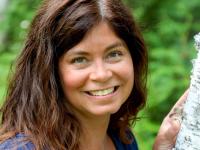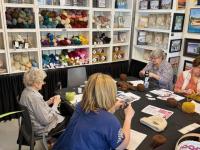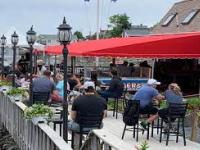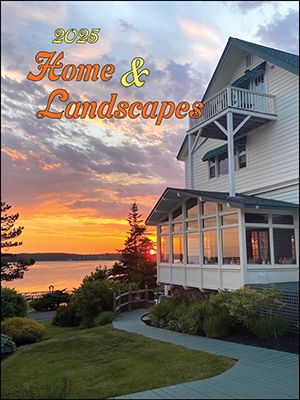Buffering our watersheds
How can plants help protect water quality and lower bills? Ask Rebecca Jacobs, natural resources program manager at Boothbay Region Water District. This March, she gave a talk at Coastal Maine Botanical Gardens on the benefits of vegetative buffers, especially for watersheds. According to her, it’s a lush list.
The foundation of the Boothbay region's watersheds are Knickerbocker Lake and Adams Pond, which help the water district annually pump over 200 million gallons of water to Boothbay, Boothbay Harbor and Southport. However, they are both surface water sources and their small size makes them especially sensitive. Jacobs said they are categorized by the state as “threatened” due to human development and associated pollution.
Pollution doesn't just mean littered cans and trash bags. Jacobs said polluted lakes are also more likely to have algal blooms. Algal blooms can be harmful to health but also property values, local economy and tourism. If a lake is in poor shape, “people are not going to want to vacation on your cottage,” she said.
Excess nutrients, such as phosphorus and nitrogen, increase the risk of algae growth. Eutrophication, the process by which water becomes enriched with nutrients, can take thousands of years. A lake can eventually reach a eutrophic state, where nutrient excess leads to an overabundance of plants and algae and oxygen scarcity. However, the timeline can be drastically reduced with human influence, such as nutrient pollution from fertilizers and increased runoff.
”You can take what's a hundreds-and-thousands-of-years process and you can amplify it into decades,” she said. “To say that we don't have an effect on the landscape is just a misnomer. We are directly impacting the timeline. We are changing the timeline of the natural process.”
Where does that leave Boothbay? Jacobs said Adams Pond and Knickerbacker Lake are not eutrophic ... yet. She reported phosphorus and chlorophyll levels from 2000-2023 that were below eutrophic levels. However, some were only shy by one or two parts per billion until they move one step closer to eutrophy.
“We're healthy, but we're right on the cusp,” she said. “Everything we are doing ... on the landscape as humans, is impacting and has the potential to tip the scales.”
However, the scales can be tipped in either direction. She said the best way to protect drinking water is land conservation around the source, and added conservation is cheaper for rate payers than millions of dollars in water treatment. According to Jacobs, over 90% of the Boothbay watersheds are undeveloped and forested, but that doesn't guarantee conservation.
"There is a difference between having 90% of the forest currently undeveloped and it remaining undeveloped,” she said. “There are several parcels and locations throughout the watersheds that could be subdivided and developed, and current trends indicate the likelihood it will be unless conserved.”
Jacobs said studies show conserving 75% of Boothbay's watershed lands would adequately protect water quality, and close to 30% is currently protected through easements or conservation purchases.
But conservation can also happen in backyards, and landowners can protect water quality by planting vegetative buffers. These buffers can provide a laundry list of benefits according to Jacobs. They provide a wind break, help recharge groundwater, shelter wildlife, give shade, and even help relationships.
“Maybe you're here because you just want a buffer from your neighbor,” Jacobs said. “Sometimes good vegetative buffers make good neighbors.”
Vegetative buffers also help protect lakes, rivers and adjacent properties. One of their clearest benefits is how they can reduce runoff and erosion. Above ground, leaves intercept rainfall that may otherwise erode soil on impact. Underground, their root systems stabilize soil and allow water to infiltrate the ground, which helps slowly disperse it. Plants can also absorb excess nutrients and trap pollutants, protecting downstream resources.
Jacobs said the best buffers are made from native plants that coexist with local soils and ecology. A mix of trees, shrubs and grassy meadows can help, especially arranged in ways to limit erosion. For example, a serpentine path is better than a bald meadow for downhill slopes. However, what makes a good buffer can look different for each property, so planning can pay off.
For those inspired to plant buffers, Jacobs recommended buying native plants from a local nursery familiar with regional soil conditions and vegetation, rather than a far-away website. “If they’re not using botanical names don't buy from them,” she said.
For more information on native plants and soils in your area, Jacobs recommended reaching out to Knox-Lincoln Soil & Water Conservation District by email at info@knox-lincoln.org or phone at (207) 596-2040. The talk was part of the Forests to Faucets Lectures, an ongoing series from the Boothbay Region Clean Drinking Water Initiative.





























